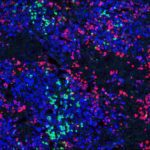Link to Pubmed [PMID] – 21788504
Proc. Natl. Acad. Sci. U.S.A. 2011 Aug;108(32):13224-9
The homeostatic control mechanisms regulating human leukocyte numbers are poorly understood. Here, we assessed the role of phagocytes in this process using human immune system (HIS) BALB/c Rag2(-/-)IL-2Rγc(-/-) mice in which human leukocytes are generated from transplanted hematopoietic progenitor cells. Interactions between signal regulatory protein alpha (SIRPα; expressed on phagocytes) and CD47 (expressed on hematopoietic cells) negatively regulate phagocyte activity of macrophages and other phagocytic cells. We previously showed that B cells develop and survive robustly in HIS mice, whereas T and natural killer (NK) cells survive poorly. Because human CD47 does not interact with BALB/c mouse SIRPα, we introduced functional CD47/SIRPα interactions in HIS mice by transducing mouse CD47 into human progenitor cells. Here, we show that this procedure resulted in a dramatic and selective improvement of progenitor cell engraftment and human T- and NK-cell homeostasis in HIS mouse peripheral lymphoid organs. The amount of engrafted human B cells also increased but much less than that of T and NK cells, and total plasma IgM and IgG concentrations increased 68- and 35-fold, respectively. Whereas T cells exhibit an activated/memory phenotype in the absence of functional CD47/SIRPα interactions, human T cells accumulated as CD4(+) or CD8(+) single-positive, naive, resting T cells in the presence of functional CD47/SIRPα interactions. Thus, in addition to signals mediated by T cell receptor (TCR)/MHC and/or IL/IL receptor interactions, sensing of cell surface CD47 expression by phagocyte SIRPα is a critical determinant of T- and NK-cell homeostasis under steady-state conditions in vivo.

